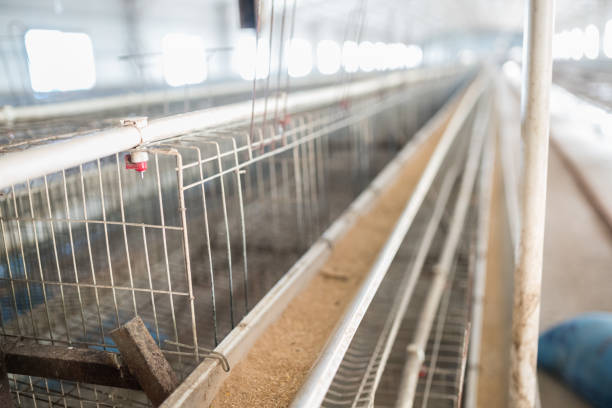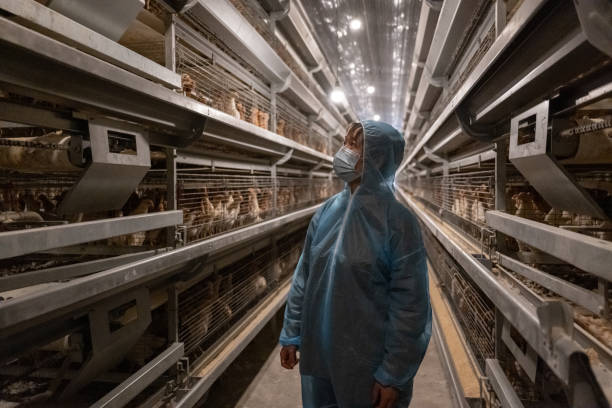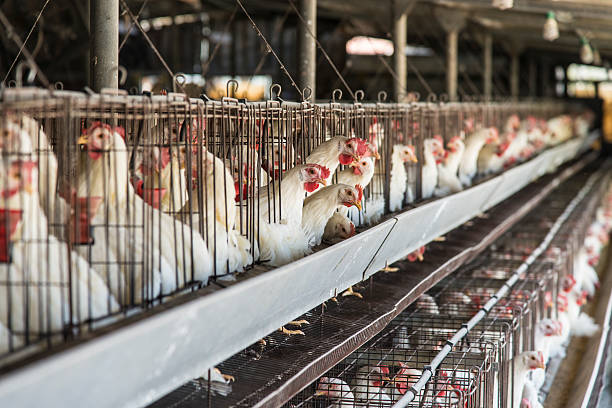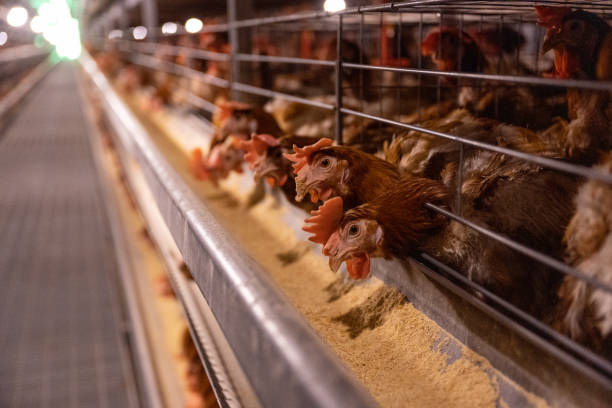
Automated Poultry Cage Systems: Understanding Pricing for African Poultry Farms
Automated Poultry Cage Systems: Understanding Pricing for African Poultry Farms
For ambitious poultry farmers across Africa aiming for significant production gains and streamlined operations, automated poultry cage systems represent a game-changing investment. However, understanding the pricing structure of these systems can be complex. This article breaks down the key factors influencing the cost of automated poultry cage systems, providing crucial insights to help African poultry farms make informed decisions.
Why Automate? The Benefits of Automated Poultry Cage Systems
Before diving into pricing, it’s essential to understand why automation is becoming increasingly popular in African poultry farming. The transition from traditional methods to automated systems offers a plethora of advantages:
Increased Efficiency: Automated systems streamline essential tasks like feeding, watering, egg collection, and manure removal, drastically reducing labor requirements and saving time.
Improved Bird Health and Welfare: Consistent feeding and watering schedules, coupled with efficient waste management, create a healthier environment for chickens, leading to reduced stress and disease.
Higher Egg Production: Optimizing living conditions and minimizing stress directly translates to improved egg-laying rates and overall productivity.
Reduced Labor Costs: Automation significantly reduces the need for manual labor, resulting in substantial cost savings over the long term. In areas where labor costs are high or labor is scarce, this is a particularly significant benefit.
Enhanced Biosecurity: Closed cage systems minimize contact with external contaminants, reducing the risk of disease outbreaks.
Better Manure Management: Automated manure removal systems improve hygiene and provide opportunities for manure processing and sale as fertilizer.
Scalability: Automated systems are easily scalable, allowing farms to expand their operations and increase production capacity to meet growing market demands.
Key Factors Influencing the Price of Automated Poultry Cage Systems
The cost of an automated poultry cage system is influenced by a variety of factors. Understanding these factors is crucial for budgeting and selecting the right system for your farm.
System Type: Layer vs. Broiler Cages
The type of poultry you raise – layers (egg-laying chickens) or broilers (meat chickens) – significantly affects the system design and therefore the cost.
Layer Cage Systems: Layer cage systems are designed to maximize egg production and bird comfort over an extended laying period (typically around 72 weeks). They often include features like:
Sloped floors for easy egg roll-out.
Individual feeding and watering troughs for each cage compartment.
Automated egg collection belts.
Manure removal systems (belt or scraper).
Broiler Cage Systems: Broiler cage systems are designed for rapid growth and efficient meat production in a shorter timeframe (typically 6-8 weeks). Key features include:
Robust cage construction to withstand the rapid growth of broilers.
Optimized floor space to accommodate a higher density of birds.
Efficient feeding and watering systems to support rapid weight gain.
Easier access for bird removal at the end of the growing cycle.
Layer cage systems tend to be more complex and expensive due to the added features for egg collection and extended bird welfare. Broiler cage systems, while simpler, still require durable construction and efficient resource delivery, which contribute to their overall cost.
Cage Configuration and Size:
The size and layout of the cage system directly impact the material requirements and manufacturing complexity, influencing the price. Common cage configurations include:

A-Frame Cages: These cages are arranged in an A-shape, with tiers stacked on top of each other. They are relatively affordable and space-efficient, suitable for smaller farms.
H-Frame Cages: H-frame cages are more robust and offer better ventilation and manure management. They are ideal for larger, more intensive operations, but tend to be more expensive.
Vertical/Stacked Cages: These systems maximize space utilization by stacking multiple tiers of cages vertically. They are ideal for farms with limited land availability but require careful planning and ventilation to ensure bird health.
The number of tiers per cage row, the number of rows per house, and the overall size of the system will all factor into the total cost. Larger systems generally benefit from economies of scale, reducing the per-bird cost.
Level of Automation:
The level of automation integrated into the system is a major determinant of price. Systems can range from semi-automated to fully automated, with varying degrees of technological sophistication.
Semi-Automated Systems: These systems typically include automated feeding and watering but may require manual egg collection and manure removal. They offer a good balance between cost and labor savings, making them suitable for mid-sized farms.
Fully Automated Systems: These systems automate all major tasks, including feeding, watering, egg collection, manure removal, and climate control. They offer the highest level of efficiency and labor savings but also come with a higher initial investment.
The inclusion of features like computerized feeding systems, automated climate control, and advanced egg sorting and packing equipment will significantly increase the price of the system.
Materials and Construction Quality:
The materials used in cage construction and the overall build quality affect the system’s durability, lifespan, and performance.
Cage Material: Galvanized steel is the most common material for poultry cages due to its strength, corrosion resistance, and affordability. However, the gauge (thickness) of the steel and the quality of the galvanization process can vary, affecting the price and longevity of the cages.
Construction Techniques: The quality of welding, assembly, and overall construction influences the structural integrity and lifespan of the system. Well-built cages will withstand the rigors of daily use and resist damage from cleaning and handling.
Component Quality: The quality of components such as motors, gears, belts, and control systems also affects the overall cost and reliability of the system. Using high-quality components from reputable manufacturers will ensure smooth operation and minimize downtime.
Opting for higher-quality materials and construction may increase the upfront cost but will result in a longer lifespan, reduced maintenance requirements, and improved performance in the long run.
Equipment Features and Technologies:
Various additional features and technologies can be integrated into automated cage systems to enhance performance and bird welfare. These features contribute to the overall cost.
Climate Control Systems: Ventilation, heating, and cooling systems regulate temperature and humidity, optimizing bird comfort and reducing stress. These systems can be manual or automated, with automated systems offering greater precision and efficiency.
Lighting Systems: Proper lighting is crucial for egg production and bird behavior. LED lighting systems are energy-efficient and can be programmed to mimic natural daylight cycles, improving egg-laying rates.
Drinking Systems: Nipple drinkers are a popular choice for automated cage systems, providing a clean and consistent water supply while minimizing wastage.
Feeding Systems: Chain feeding systems, auger feeding systems, and volumetric feeders deliver feed efficiently to each cage, ensuring uniform feed distribution and minimizing spillage.
Egg Collection Systems: Automated egg collection systems use belts and conveyors to transport eggs from the cages to a central collection point, reducing manual labor and minimizing egg breakage.
Manure Removal Systems: Scraper systems and belt systems efficiently remove manure from the cages, improving hygiene and reducing ammonia buildup.
Control Systems: Computerized control systems monitor and manage various aspects of the poultry house, including temperature, humidity, lighting, feeding, and watering. These systems can be programmed to optimize conditions for bird health and productivity.
Transportation and Installation Costs:
Transportation and installation costs can significantly impact the overall investment, especially for farms located in remote areas.
Distance from Supplier: The distance between the supplier’s manufacturing facility and the farm will affect transportation costs. Selecting a supplier closer to your location can help minimize these costs.
Shipping Method: The shipping method (sea freight, air freight, or road transport) will also influence transportation costs. Sea freight is generally the most economical option for large shipments, while air freight is faster but more expensive.
Installation Services: Professional installation services ensure that the system is properly installed and calibrated, guaranteeing optimal performance. Installation costs will vary depending on the complexity of the system and the labor rates in your area.
It is crucial to factor in transportation and installation costs when budgeting for an automated poultry cage system. Obtain quotes from multiple suppliers and compare their transportation and installation fees.
Supplier Reputation and After-Sales Service:
The reputation and after-sales service offered by the supplier are critical factors to consider.
Supplier Experience: Choose a supplier with a proven track record of providing reliable and efficient poultry cage systems.
Warranty and Support: Ensure that the supplier offers a comprehensive warranty and provides ongoing technical support and maintenance services.
Spare Parts Availability: Verify that the supplier stocks spare parts and can provide timely replacements in case of breakdowns.
Customer Reviews: Read customer reviews and testimonials to gauge the supplier’s reputation and customer satisfaction.
Investing in a reputable supplier with excellent after-sales service will provide peace of mind and ensure that your system operates smoothly for years to come.
Getting a Clear Picture: Obtaining Accurate Quotes
To accurately estimate the cost of an automated poultry cage system for your farm, follow these steps:
Define Your Needs: Clearly define your production goals, flock size, and budgetary constraints.
Research Suppliers: Identify reputable suppliers specializing in automated poultry cage systems in Africa or with experience in serving the African market.
Request Detailed Quotes: Provide suppliers with detailed information about your farm size, building dimensions, desired level of automation, and specific requirements. Request detailed quotes that include:
Cage system specifications (dimensions, materials, configuration).
Equipment list (feeding system, watering system, egg collection system, manure removal system, climate control system).
Automation level (semi-automated or fully automated).
Transportation costs.
Installation costs.
Warranty information.
Payment terms.
Compare Quotes: Carefully compare the quotes from multiple suppliers, paying attention to the specifications, features, and overall value offered.
Negotiate Prices: Don’t hesitate to negotiate prices with suppliers to get the best possible deal.
Visit Reference Farms: If possible, visit reference farms that have installed similar systems to see them in operation and talk to other farmers about their experiences.
Financial Considerations: ROI and Long-Term Cost Savings

While the initial investment in an automated poultry cage system can be substantial, it’s important to consider the long-term cost savings and return on investment (ROI).
Reduced Labor Costs: Automation significantly reduces the need for manual labor, resulting in substantial cost savings over time.
Increased Egg Production: Optimizing living conditions and minimizing stress can lead to significant increases in egg production, boosting revenue.
Improved Feed Conversion Ratio: Efficient feeding systems minimize feed wastage, improving the feed conversion ratio and reducing feed costs.
Reduced Mortality Rates: A healthier environment and better management practices can reduce mortality rates, increasing the number of birds reaching maturity.

Manure Sales: Automated manure removal systems provide opportunities for manure processing and sale as fertilizer, generating additional revenue.
To calculate the ROI, estimate the annual cost savings and revenue increases resulting from automation and compare them to the initial investment. A well-designed and properly managed automated system can provide a significant ROI within a few years.
Conclusion: Making an Informed Investment
Investing in an automated poultry cage system is a significant decision for African poultry farms. By understanding the factors influencing pricing, obtaining accurate quotes, and considering the long-term benefits, farmers can make informed choices that will lead to increased efficiency, higher productivity, and improved profitability. Embrace automation and unlock the full potential of your poultry farm.
